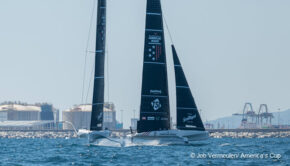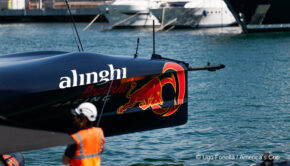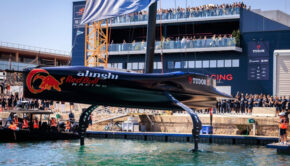America’s Cup: Late but worth the wait
Published on May 20th, 2019
Terry Hutchinson, skipper of New York Yacht Club’s team that’s challenging for the 36th America’s Cup, has been patient. The plan was for American Magic to launch their first AC75 by the first date permitted, March 31st. That was Plan A. So much for Plan A.
What’s missing has been the bird-like foil arms that are being supplied by the Defender and Challenger of Record to all the teams. There are a number of one design parts for the 36th edition, and the foil system was among the list, but problems have slowed the delivery. Scuttlebutt editor Craig Leweck checks in with Terry for an update:
Providing one-design parts is meant to save time and money, right?
It is an effort to do that. Certainly with the development of the control system for the foil arm, and for the actual arm itself, it’s definitely an effort towards trying to equalize gear and to help reduce some of the cost. It’s a complex piece of equipment and what they are doing is not easy, so from our perspective, it’s one less thing we have to focus on.
But that has to make this delay frustrating when it is out of your control. What has been the problem?
When they tested the arms back in the early fall, they didn’t meet the safe working load requirement – they failed well before it. So the good news is how there was a process in place. It’s great that there was suitable representation from all the teams, that nothing got by that wasn’t safe.
If you look at it in the glass-half-full manner, which we do, safety is a big one, so they did the right thing and they hit the big red button and stopped the production and everybody got involved to work through the problem for a good solution.
When did you know plan A wasn’t going to work?
This was September 2018, and the news was not a complete shocker. As time played on and things were being designed and built, and the foil arms were progressing, the original production and original engineering that was taken on was quite complex and complicated.
We have in our team Silvio Arrivabene and Kurt Jordan who basically did that type of design and construction for Alinghi. They knew the pitfalls of what was being proposed, they thought it was aggressive, they thought it was hard, and that potentially a more conservative approach would be better for the execution.
However, providing these one design parts is not our responsibility and we only gave feedback when asked. Fast forward to where we are sitting here today. We didn’t plan for the delay to happen. We had nothing to do with it, but the fact that it did, it is what it is from our perspective.
Jumping up and down and yelling and screaming about it isn’t going to change anything, so why even bother? It’s a little bit like the class rule. We didn’t really have a part in it when the rule was written and so all we have is the document. Instead of being focused on the pitfalls of it, we’re focused on dealing with it. Again, it is what it is, so just proceed and do the best job that we possibly can, because all the teams are in the same spot.
Did this allow allow you to pull the handbrake on construction and commit more time toward design? Or were you already too far down the pike at that point?
For us to meet the March 31st launch date, at least in a hull perspective, we had to submit things earlier rather than later. So when we submitted our hull drawings, we made that decision six weeks before the foil alarms were actually tested. The time we had to get that boat designed and built was really tight, but we were always proceeding knowing that the first boat was not going to be our final race boat. The plan was always to build a second boat.
Were you able to benefit at all from the delay?
We haven’t been sitting still. We’ve been able to dedicate this energy elsewhere, which has allowed us to be a bit more methodical with the structure and systems.
With the changes they’ve made to the approved foil arms, does that impact anything that you’ve got to do to the hull to strengthen or redesign certain areas?
There has been some changes on the attachments inside the hull, but nothing we couldn’t adapt to. The weight has changed, so the class rule has been updated. Again, it’s one of those things that we try not to get too fussed about it because it’s out of our control. Our only move is to take what we’re given.
The foil arms are an immensely vital piece of equipment. Was there ever a time when it was considered to delay the regatta?
Never, but I know there were people on the outside ranting about this possibility, but they were peddling opinion from a position of ignorance. Looking back to 2013, the AC72 was an aggressive design that went through a period that was very, very difficult. Everybody saw the pitfalls of what happened when things weren’t done properly, and that was a tragedy, but that’s also the game we are playing. With the AC75, we continue to reach further into the unknown, and that is hard to do.
So the situation was never remotely close to being that dire?
No. We go out sailing nearly every day on our 50% scale model boat, the Mule, and I can assure you it’s hard. But I can also assure you that it’s safe as well. However, that doesn’t mean people don’t get hurt. The risk of people being hurt, or even worse, is there, but we deal with risk throughout our lives, whatever we are doing, and plan accordingly. So anybody who said the regatta should have been delayed, at the least, had no idea what they were talking about, and perhaps also were serving another agenda outside of winning the regatta.
But this delay had to have been frustrating.
For sure, we’re all dying to get our hands on these parts so that we can get our big boats going, but throughout we continued to encourage the Challenger of Record, who had taken on the task, and Persico, who was the builder, to be prudent, to make sure it is safe for the teams when it’s delivered.
So yes, the delays were unfortunate, but so be it as this was our one opportunity to get it right, and there still is time to learn how to sail our boats.
I give Persico a lot of credit, because they have not been tempted to speed up the process. They are going about it in the right way. These people are the best in the business, so however long it takes is how long it takes because we can’t put the fleet or the regatta in the situation where these pieces of equipment fail. These are no fail items.
You did get people excited when your recent video showed the Mule had capsized.
Yes, these boats do that. We also saw Oracle’s AC72 pitch bow in San Francisco Bay in October 2012. This is the high performance game we are playing, and if it was easy everybody would be doing it. But it’s not easy. This is incredibly hard, and as the person who’s responsible for all of our team members, and accountable to our principles and members at the New York Yacht Club, I take it all incredibly seriously, yet at the same time, we’re in a competition to win the regatta.
It would be a mistake to think, even as we’re talking right now, that the competition is not happening because it is, and we know it is. So for our team, we can’t get bogged down in certain things, and the foil arms is a perfect example, or the cant system not delivered as was detailed to us. These are realities and we can choose to moan about it or we can choose just to work through it and get on with it while maintaining our focus on our sailing team, which we’re doing, and our design team, because those are the things we can control.
The good news came last week that the foil arms passed the tests. When can we expect to see your AC75 in the water?
Probably by early August.
How does this delay impact boat number two?
It doesn’t impact number two, but as I said earlier, if we’d known about this delay before we had to submit the design for number one, that boat would have been different. Boat one was designed in a very short period of time, and so it’s a reasonably conservative boat because we’re always targeting the launch on March 31. Since the class rule was solidified in June 2018, I think our design team had only about six weeks to execute. It will be a learning boat to get us going, but given the thousands of hull shapes that have since been run through the computer, the second boat is going to be significantly better.
And the second boat will be launched when?
I don’t know yet. We have a little bit of a wiggle room in the fall of 2020. We will decide how long we want to push it and how much time we need to reliably build it.
Have you closed your winter base in Florida?
Yes, we finished our training on Pensacola Bay last week. The venue was beyond ideal and our plan is to return this fall with our AC75 and the Mule for a second winter training program in Pensacola. But now we are back to Rhode Island. Our dedicated construction facility is in Bristol, and we look forward to getting these missing parts so we can go sailing this summer in Narragansett Bay.
In addition to Challenges from Italy, USA, and Great Britain that were accepted during the initial entry period (January 1 to June 30, 2018), eight additional Notices of Challenge were received by the late entry deadline on November 30, 2018. Of those eight submittals, entries from Malta, USA, and The Netherlands have also been accepted. Here’s the current list:
Defender:
• Emirates Team New Zealand (NZL)
Challengers:
• Luna Rossa (ITA) – Challenger of Record
• American Magic (USA)
• INEOS Team UK (GBR)
• Malta Altus Challenge (MLT)
• Stars & Stripes Team USA (USA)
• DutchSail (NED)
Key America’s Cup dates:
✔ September 28, 2017: 36th America’s Cup Protocol released
✔ November 30, 2017: AC75 Class concepts released to key stakeholders
✔ January 1, 2018: Entries for Challengers open
✔ March 31, 2018: AC75 Class Rule published
✔ June 30, 2018: Entries for Challengers close
✔ August 31, 2018: Location of the America’s Cup Match and The PRADA Cup confirmed
✔ August 31, 2018: Specific race course area confirmed
✔ November 30, 2018: Late entries deadline
✔ March 31, 2019: Boat 1 can be launched (DELAYED)
✔ 2nd half of 2019: 2 x America’s Cup World Series Preliminary Events (CANCELLED)
February 1, 2020: Boat 2 can be launched
During 2020: 3 x America’s Cup World Series Preliminary Events
December 10-20, 2020: America’s Cup Christmas Race
January and February 2021: The PRADA Cup Challenger Selection Series
March 2021: The America’s Cup Match
Details: www.americascup.com









 We’ll keep your information safe.
We’ll keep your information safe.